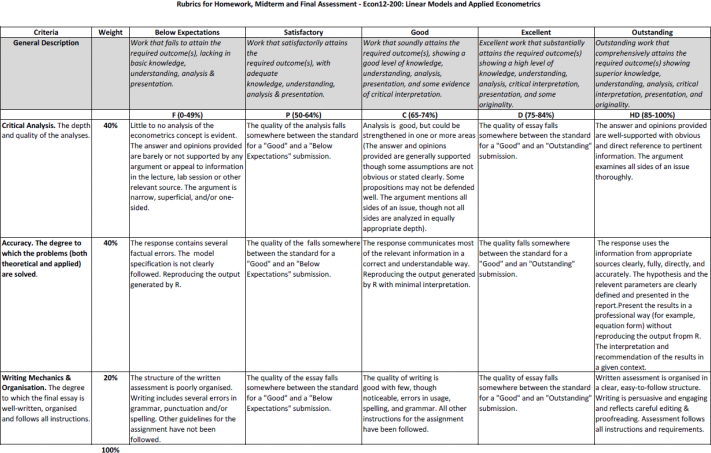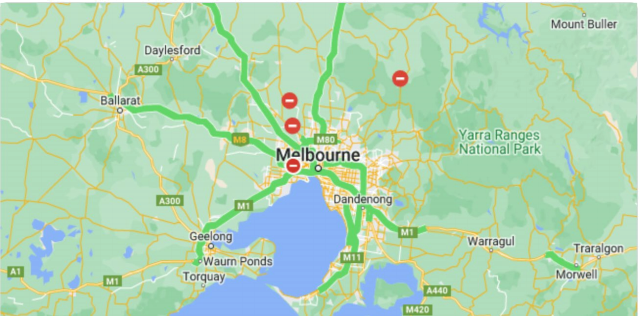关键词 > ECON12-200
ECON12-200 Linear Models and Applied Econometrics
发布时间:2024-06-15
Hello, dear friend, you can consult us at any time if you have any questions, add WeChat: daixieit
ECON12-200 Linear Models and Applied Econometrics
Homework 1:
Due in Week 5 by Friday 4pm
Learning Outcomes covered in this assessment:
1. Demonstrate knowledge of linear regression, its maintained assumptions and their relevant statistical properties.
2. Use simple/multiple regression models to interpret the underlying relationships between the variables and evaluate their statistical significance through hypothesis testing.
4. Demonstrate the ability to solve business problems using econometrics packages.
5. Demonstrate the ability to produce a written report that demonstrates higher order understanding of key concepts in applied econometrics.
Context
Regression analysis is a powerful statistical tool used in real life for various purposes, primarily to model and analyse relationships between variables.
Formatting
Assignment can be typed or hand-written or combinations of both. If it is hand-written, take an image and convert them into PDF. Homework assignments must be submitted in iLearn in a single PDF file.
Use of Artificial Intelligence
You can utilise GAI to assist with your questions However, you must adapt the AI-
generated answers to conform with the methods taught in this course. Students maybe
asked to explain their answers if they use a different approach from what is taught in
class in order to receive full credit. Be sure to appropriately reference any cited
materials. Inappropriate use of subject content or other sources in your response will be
considered a breach of the University’s academic integrity policy. Refer to the Bond University Generative Artificial Intelligence (GAI) resources for guidance. All
assessments must include aStatement of Authorship.
Academic Integrity
Academic Integrity means adhering, in words and actions and across all aspects of student life, to an academic moral code bound by Bond’s seven integrity principles of honesty, trust,
fairness, respect, responsibility, courage, and professionalism. Breaches of academic
integrity are known as either poor scholarship or academic misconduct. The University
supports Academic Integrity by providing students with resources and support. Visit
Academic Integrity at Bondor seek support from your educators,BondCare support servicesincluding theAcademic Skills Centre, orLibrary services.
Rubrics

Case: Traffic congestion
Victoria’s transport system has three major problems. The first problem is congestion and
crowding, with Victorians experiencing significant congestion on roads, trains and trams.
This means trips take longer, are less comfortable and less reliable, which costs people and
businesses time and money. The second problem is that the accepted solution of building new infrastructure to ease congestion won’t solve congestion unless they take other steps. The
third problem is that there are no incentives in the current system for people to change their behaviour. Current pricing system is simple enough, but it doesn’t encourage people to make different choices about the time, route, mode or quality of their trip. This means that even as congestion worsens, people are not motivated to change their behaviour.

In this case study, we observe the movement of Prof. Bill Griffith on each morning between 6.30AM and 8.00AM, who leaves the Melbourne suburb of Carnegie to drive to work at the University of Melbourne. The time it takes Bill to drive to work (TIME) depends on the
departure time (DEPART), the number of red lights that he encounters (REDS), and the number of trains that he has to wait for at the Murrumbeena level crossing (TRAINS). Observations on these variables for the 231 working days in 2006 appear in the file
“Homework1.xlsx” . TIME is measured in minutes. DEPART is the number of minutes after 6.30AM that Bill departs.
You will assist Prof. Griffith to develop a model to predict the time it takes Bill to drive to work.
Question1
Professor observes the following based on the sample of 18 trips:

where y = the time it takes Bill to drive to work and x = departure time. Answer the
following based on the summary information above 18 trips. Note: Do not use Excel file to answer Question1.
(a) Compute the correlation coefficient between x andy. (4 Marks)
(b) Compute the least squares estimates of β1 and β2 in the model: y = β1 + β2 x + e . Interpret the regression coefficients. (8 Marks)
(c) Find and interpret the 99% confidence interval for β1 assuming that the standard error of b1 is 3.2. (4 Marks)
(d) Find and interpret the 90% confidence interval for β2 assuming that the standard error of b2 is 0.1. (4 Marks)
(e) Is there a linear relationship between y and x at the 1% level of significance assuming that the standard error of b2 is 0.1? (5 Marks)
(f) Is there a positive linear relationship between y and x at the 1% level of significance assuming that the standard error of b2 is 0.1? (5 Marks)
Question 2
Consider the regression model: ln(TIME) = β1 + β2 ln(DEPART) + e . (1)
(a) Estimate equation (1) using least squares technique and report the results. (3 Marks)
(b) Interpret the regression coefficients. (4 Marks)
(c) Find and interpret the 90% confidence interval for β1 . (4 Marks)
(d) Find and interpret the coefficient of determination. (3 Marks)
(e) Using a 10% significance level, based on the model estimated in (a), test the
hypothesis that departure time has a positive effect on the time to travel to work. Clearly present the test statistic and the restricted model. (6 Marks)
(f) Based on the model estimated in (a), determine the time to travel to work when the DEPART is equal to 50. (3 Marks)
Question 3
Consider the regression model:
TIME = β1 + β2TRAINS +β3REDS +β4 ln(DEPART) + e . (2)
(a) Estimate equation (2) and report the regression results. (3 Marks)
(b) Interpret the estimated coefficients. (10 Marks)
(c) Compute the variance of the residual (e) series. (3 Marks)
(d) Using the model estimated in (a), find and interpret the 99% confidence interval for β3 and β4 . (8 Marks)
(e) Find and interpret the coefficient of determination. (3 Marks)
(f) Using a 1% significance level, test the following hypotheses,
(i) A one percent increase in the departure time increases the TIME by 1 unit. (5 Marks)
(ii) Each red light increases the TIME by 2 units. (5 Marks)
(g) Use the confidence interval approach to test the following hypotheses at the 5% significance level,
(i) Each train increases the TIME by 3 units. (5 Marks)
(ii) Each red light increases the TIME by 2 units. (5 Marks)

